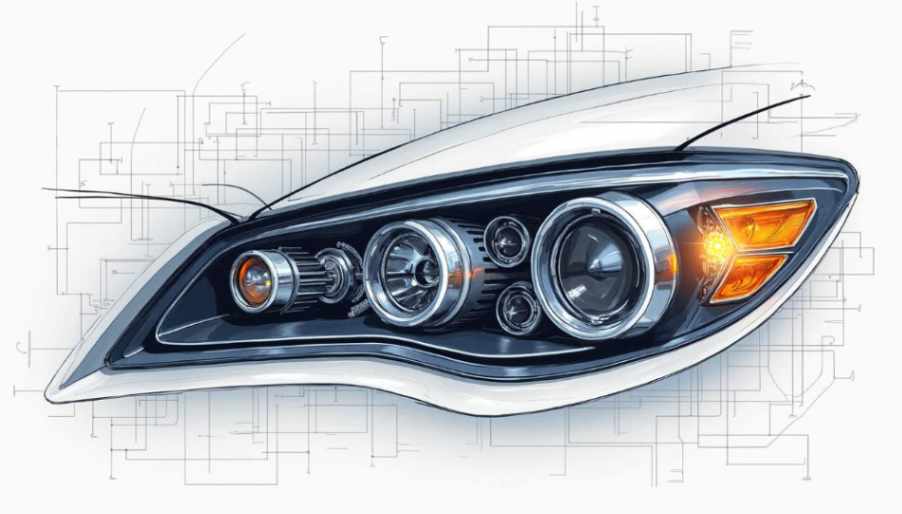When it comes to upgrading your vehicle's lighting system, the options for headlights can be overwhelming. Among the most popular types are LED (Light Emitting Diode) and HID (High-Intensity Discharge) headlights. Each offers distinct advantages and disadvantages, making it crucial to understand the differences before making a decision. This article will dive into the details of both headlights, helping you decide which is the best fit for your needs.
Understanding the Basics of Headlights
Headlights are essential for safe driving at night and during inclement weather. They illuminate the road ahead, allowing for increased visibility and reduced risk of accidents. Headlights come in various types, with two of the most prominent being LED and HID. Knowing the basic differences can help you make an informed choice.
What are LED Headlights?
LED headlights utilize semiconductor technology to produce light. They are highly efficient and have rapidly gained popularity in the automotive industry due to their energy-saving capabilities. LED lights emit bright, clear illumination while consuming less power, making them an environmentally friendly option.
Additionally, LED headlights have the ability to turn on instantly and provide uniform lighting across the road. This offers better visibility for both the driver and oncoming traffic. Their compact size allows for versatile designs in vehicles, enhancing aesthetics as well. Furthermore, LED technology has advanced to include adaptive lighting systems, which adjust the beam pattern based on driving conditions, ensuring optimal illumination without blinding other drivers. This innovation not only improves safety but also enhances the overall driving experience, making nighttime travel more comfortable.
What are HID Headlights?
HID headlights work by creating an electric arc between two electrodes within a gas-filled chamber. This arc produces a bright light that is significantly brighter than traditional halogen bulbs. HID lights are known for their long-range visibility and are favored for off-road and performance-driven vehicles.
It’s important to note that HID headlights often require time to reach their full brightness, which can take a few seconds. However, once warmed up, they provide a strong beam that enhances nighttime driving capabilities. Additionally, HID headlights can produce a color temperature that mimics natural daylight, which can reduce eye strain during long drives. This feature is particularly beneficial for those who frequently drive at night or in low-light conditions. However, it’s essential to ensure that HID headlights are properly installed and aligned to avoid glare, which can be hazardous to other drivers on the road.
The Technology Behind LED and HID Headlights
Both LED and HID headlights represent impressive advances in automotive lighting technology. Understanding how they function will help you appreciate their unique benefits.
How LED Headlights Work
LED headlights consist of diodes that emit light when an electrical current passes through them. This process is known as electroluminescence. Because LEDs generate light without the need for a filament or gas, they are more robust and less prone to breaking.
The color temperature of LED headlights can vary, offering drivers a range of options from warm yellow to cool white. Modern LED technology also includes features such as adaptive lighting, which adjusts the beam pattern based on driving conditions and steering angles for optimal visibility. Additionally, LED headlights are known for their energy efficiency, consuming significantly less power than traditional halogen bulbs. This not only results in lower energy costs but also reduces the load on the vehicle’s electrical system, potentially extending the lifespan of the battery.
Another noteworthy aspect of LED headlights is their longevity. While traditional bulbs may need to be replaced every few thousand hours, LED lights can last up to 25,000 hours or more, making them a cost-effective choice over time. Furthermore, the compact size of LED units allows for innovative designs in headlight assemblies, enabling manufacturers to create sleeker, more aerodynamic vehicle profiles.
How HID Headlights Work
HID headlights operate through a different mechanism. Instead of a filament, these lights use xenon gas, which creates light when subjected to high voltage. The initial surge of electricity ignites the gas, creating a bright arc between the electrodes.
One of the primary advantages of HID headlights is their color temperature, which can be achieved through varying the gas mixture. This allows for different hues ranging from a warmer yellow to a cooler blue, depending on personal preference. Moreover, HID headlights produce a significantly brighter light output compared to traditional halogen bulbs, enhancing visibility during nighttime driving or in poor weather conditions. This increased brightness can be particularly beneficial for drivers navigating dark rural roads or inclement weather, as it illuminates a wider area and improves overall safety.
However, it is worth noting that HID headlights require a warm-up period to reach their full brightness, which can take a few seconds. This characteristic can be a drawback in situations where immediate illumination is necessary. Additionally, the installation of HID headlights often requires specific housing and wiring, making retrofitting them into vehicles originally designed for halogen lights a more complex endeavor. Despite these considerations, the striking brightness and distinctive color options of HID headlights continue to attract car enthusiasts and those seeking enhanced visibility on the road.
Comparing LED and HID Headlights
When choosing between LED and HID headlights, there are several key comparisons to consider: brightness, energy efficiency, lifespan, and durability.
Brightness and Visibility
LED headlights typically emanate a brighter, more focused beam, while HID headlights generate a wider spread of light. This distinction affects how well each type illuminates the road ahead and the surrounding areas.
An individual’s driving habits and the types of roads they frequent may dictate which option works best. For instance, those who drive in rural areas may appreciate the broader beam of HID lights, while city drivers may benefit from the concentrated light of LEDs. Additionally, the color temperature of the light emitted by each type can influence visibility; LEDs often produce a cooler, whiter light that can enhance contrast and make it easier to spot obstacles in the road, while HIDs can emit a bluish hue that some drivers find appealing but may not provide the same level of clarity in certain conditions.
Energy Efficiency
Energy efficiency is one of the standout advantages of LED headlights. They consume significantly less wattage compared to both HID and halogen lighting options. This efficiency means that more power can be utilized for other electrical components in the vehicle, ultimately improving fuel economy.
Lifespan and Durability
LED headlights boast an impressive lifespan of around 25,000 to 50,000 hours, far exceeding the 2,000 to 3,000 hours offered by HID headlights. This longevity means less frequent replacements, saving both time and money in the long run.
Cost Analysis: LED vs HID Headlights
Cost is often a significant factor when choosing headlights, and understanding the financial implications of each option can aid in making a smart decision.
Initial Purchase Cost
Typically, LED headlights have a higher initial purchase price compared to HID, primarily due to their advanced technology and durability. However, this initial investment can often be justified by their overall efficiency and longer lifespan.
Long-term Cost Implications
In the long run, LED headlights usually present a lower total cost of ownership due to their energy efficiency and long lifespan. Fewer replacements translate to substantial savings over time. Meanwhile, HID headlights, while initially cheaper, may incur higher maintenance and replacement costs as they age.
Considering both the short-term and long-term financial implications is vital when making a decision. Ultimately, understanding your driving habits, preferences, and budget will lead you to the best choice for your needs.












